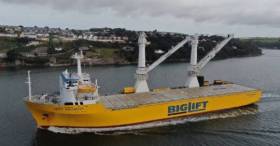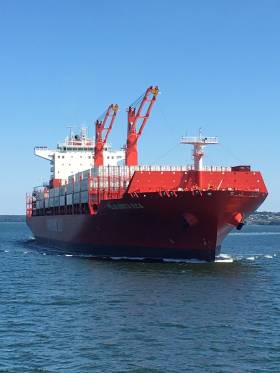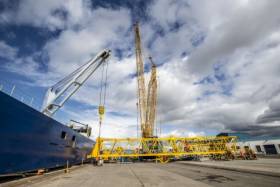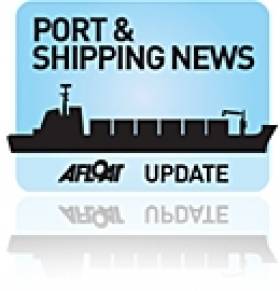Displaying items by tag: Liebherr
Busy Year for Fenit Harbour in 2022
It was a busy year for Fenit Harbour in Co. Kerry as the south-west port handled in 2022 more than a dozen vessels and roughly 24,000 tonnes of cargo.
The vast majority of the cargo is from Liebherr cranes manufactured at its plant of Fossa outside Killarney as Afloat has reported down the years. Cargo including ship to shore (STS) container cranes have been exported to countries such as the UK and the USA.
The figures on Fenit Harbour were provided by the Central Statistics Office (CSO) which as Afloat reported last week issued a full breakdown of all traffic in and out of Irish Ports which last year handled 53 million tonnes of goods.
As for the Co. Kerry port, the CSO said that 13 vessels were handled in 2022 with a combined gross tonnage of 155,000. In the previous year, the same number of cargo ships berthed at the port however several of the ships handled were considerably larger in 2022.
The Independent.ie has more statistics on the harbour.
‘Megamax’ Cranes From Cork Harbour Arrive in New York Area
Three huge cranes which left Cork Harbour at the end of August have arrived at their final destination the New York area, as RTÉ News reports.
Tom MacSweeney covered the three Limerick-built cranes upon their departure from Port of Cork on board the Big Lift Baffin for their transatlantic journey.
As our own Jehan Ashmore previously wrote, the three 150m ship-to-shore (STS) Liebherr cranes represent the largest single objects ever engineered in Ireland.
Ahoy! Take a look at the three new megamax ship to shore container cranes (STS), that recently made their journey from Cork to New York.
— Liebherr Maritime Cranes (@LH_Maritime) September 9, 2022
Stay tuned to see the first pictures from New York soon.#liebherr #shiptoshore #madeinireland #containerhandling #STS #ecoSTS pic.twitter.com/am41tSLC6E
Logistics for transporting the massive ‘megamax’ cranes were complicated by the presence of the Bayonne Bridge connecting New York and New Jersey, which has a clearance less than half that of their fully assembled height.
But the Big Lift successfully passed the bridge on schedule on Saturday afternoon (10 September) and the cranes will now be installed at Maher Terminals at Port Newark in New Jersey.
RTÉ News has more on the story HERE.
Largest Single Objects Ever Engineered in Ireland Set to Be Shipped to US East Coast Ports
In Cork Harbour on Friday operations are to commence in moving the first of three ship-to-shore container cranes built in Killarney that are destined for one of the world's largest shipping terminals located on the east coast of the US.
The three cranes were designed and manufactured in Liebherr's facility in Killarney, which specialises in cranes for shipping terminals and port operations. They are destined for the Maher Terminals at the Port of New York and New Jersey.
Cork's Doyle Shipping Group (DSG) is handling the transport operations for the cranes, including commissioning the transport vessel the Big Lift Baffin, which arrived in Cork Harbour on Sunday.
The various parts of the crane were manufactured in Killarney and were shipped to Cork either by road or by sea from the harbour in Fenit. They were then assembled in DSG's 44-acre Cork Dockyard terminal near Cobh.
However, the three cranes were only partially assembled, with the upper structure sitting on the lower structure during the transatlantic voyage. This is to keep the overall height of the shipped cranes low enough to pass under Bayonne Bridge, which connects New York to New Jersey.
Irish Examiner have more here to report on the heavy module-carrier transport ship Baffin which is berthed alongside Cork Dockyard.
Heavy Lift Ship: Crane Operation to Get Underway in Cork Harbour
In the Port of Cork a major crane-loading operation gets underway this week.
The heavy-lift ship, reports EchoLive, is the Happy Buccaneer which arrived yesterday and will be used to load five gantry cranes destined for Montreal.
The operation will be similar to the loading operation in 2017 that saw three port cranes loaded onboard the heavy transport vessel Albatross and exported to Puerto Rico.
The cranes have been manufactured by Liebherr in Killarney and will be transported to the Doyle Shipping Group's (DSG) facility in Rushbrooke where the loading operation will take place.
For more click here.
Irish Built Liebherr Cranes for Port of Cork
#PortofCork - A significant deal has been signed by Liebherr Container Cranes to supply two large gantry cranes to the Port of Cork.
The twin cranes reports The Kerryman will be located at the new container terminal at Ringaskiddy - will be designed and built at Liebherr's plant in Killarney and are due to be delivered to the Port of Cork by April 2020.
Director of Liebherr Container Cranes Pat O'Leary welcomed the deal. "We are delighted to have received this order and to continue our long-standing relationship with the Port of Cork," said Mr O'Leary.
"In the 1970s, Liebherr Container Cranes supplied the first ship to shore container cranes to the port. Since that time we have supplied further cranes, including two grab cranes; two STS cranes in 1991 and 1999; as well as a rubber tyre gantry crane, all of which continue to be key elements of the port's infrastructure".
He added "The signing of a contract for the supply of two new state-of-the-art STS cranes will help drive port productivity and boost business, not only in Cork, but also throughout Ireland."
Afloat adds these STS, ship to shore cranes are also the same type of infrastructure assembled in Cork Dockyard earlier this year and carried as deck cargo for clients ABP's Port of Hull.
As for Cork's new €80m Container Terminal, construction began in June. The project is also to feature a new public marine leisure amenity at Paddy’s Point in addition a €1m community gain fund for the Ringaskiddy area.
#Ports&Shipping - Afloat has previously reported on Liebherr cranes from it Killarney plant installed at the UK North Sea Port of Hull from where further northward in Scotland at the Port of Grangemouth news of a new multimillion pound container crane has been recently announced.
The new infrastructure is set to increase the number of ship to shore cranes at the Port of Grangemonth by 50% and change the skyline at Scotland’s largest container facility.
The addition of the third Liebherr container crane to Forth Ports’ fleet is part of a major investment programme at the port to increase handling capacity and service for customers. The 45 metre high crane, which weighs 524 tonnes, arrived in large sections on board the heavy load carrier vessel the Eemslift Ellen after sailing from Liebherr’s state of the art facility in Killarney which also designed the crane.
The crane has been unloaded onto the quayside and will now be constructed by the expert build team from Liebherr on site at the port. The crane will be ready to lift its first cargo by late October and will improve vessel turnaround times, increase capacity for growth and support existing operations. The new crane is also future proofed to enable taller straddle carriers to work underneath the crane legs, allowing the port to further increase its overall container storage capability.
Derek Knox, Grangemouth’s Port Manager, said: “This is an exciting time for the port as we welcome our new ship to shore crane. We handle some of Scotland’s most valuable exports, such as fine foods and drinks, so it is important that we deliver fast turnaround times to maintain the vessel schedules and ensure their reliability to service the Scottish export market. The new crane adds to our fleet of Liebherr ship-to-shore cranes and will provide consistency for the operations and engineering team. The Liebherr team will build the crane like a giant Meccano set over the coming weeks and we look forward to its introduction to our operations for the benefit of our customers in the autumn.”
Gerry Bunyan, Sales and Marketing Manager from Liebherr Container Cranes said: “In 2006 the Port of Grangemouth received its first Liebherr ship to shore container crane, a second followed the year after. Since that time, the cranes have been key components in the port’s success. We are thrilled to be able to continue our partnership and supply a third container crane to the port. It is particularly satisfying when a customer recognises the value that a Liebherr container crane can bring to their operation. We look forward to watching this crane help to increase further the business at Scotland’s leading container port.”
Liebherr is one of the world’s leading port crane manufacturers and this new crane, which can handle vessels with 14 containers stowed across the width of the deck, is part of Forth Ports’ focus on maintaining Grangemouth as Scotland’s number one container port. In addition to providing the facilities required to service future container volume growth for export and import cargoes both in European and worldwide markets.
As part of the ongoing major investment programme at Grangemouth, the port introduced three new ESC340 straddle carriers in 2017, increasing the fleet at the container terminal to 16. The port also added a new Hyster empty container handler to the fleet. The new straddles, empty container handler and the new Liebherr crane will increase the handling capacity for both conventional containers and reefers (refrigerated containers). A new terminal operating system and additional storage capacity have also been introduced in 2018. The construction of a new 100,000 sq.ft. warehouse within the port estate is due to be completed by December this year. It will directly link to the container terminal with access to the rail siding.
More than £6 billion worth of goods passes through Grangemouth each year including food and drink, steel plate, timber, paper and equipment for the oil and gas industry.
More Business for UK Port of Hull As New Users Served by Irish Built Ship-to-Shore Cranes
#Ports&Shipping - Earlier this year, Afloat highlighted the arrival of Irish built ship-to-shore container cranes worth £10.5 million to the UK North Sea Port of Hull where further business has since taken root, writes Jehan Ashmore.
The growing trade of containers is thanks to the new infrastructure which will double the capacity of the Hull Container Terminal (HCT) to around 400,000 containers annually. The 10-acre facility located on the Humber Estuary, operated by Associated British Ports (ABP) is the third largest short-sea container port on the UK's east coast.
The addition of the new pair of 600 tonne cranes constructed by Liebherr outside Killarney, brings to four container cranes in total located at HCT. The Irish built cranes service ships of up to 500 standard containers, had arrived fully assembled to Hull in April having been transported as deck cargo on board heavy-lift ship HHL Lagos from Cork Dockyard in Rusbrooke.
Port of Hull now handles seven additional vessels per week to include the most recent new operator, I-Motion that began a trading link in the Port of Ghent, Belgium. This development marks the first ever container service linking the Ghent port area and the UK. Of the two ships serving the route, Marus, Afloat adds was the one-time Bell Atlas of the former Bell Lines, which had major operations based out of Waterford City followed downriver at Belview Container Terminal.
The Belgium based operator, I-Motion's arrival on the Humber follows as previously reported the debut in March of Samskip's operations between Hull and Amsterdam in neighbouring Netherlands.
The upgraded facility at HCT comes equipped with four ship-to shore-cranes that operate container handling operations alongside three berths capable of berthing vessels up to 199m in length.
As for the Irish built cranes they form part of a £15 million investment by ABP Port of Hull which also includes the purchase of terminal reach stackers and tug trailers.
In addition the port has created 9,000 square metres of new storage for customers.
ABP Port of Hull's Irish Built Mega Cranes Open for Business
#Ports&Shipping - UK ports operator, Associated British Ports (ABP) celebrated a milestone as the Port of Hull’s two £10.5 million cranes built in Ireland, served their first container shipment.
The fully assembled 600 tonne cranes arrived on the Humber estuary last month from Cork Dockyard in Rusbrooke. The cranes constructed by Liebherr had been loaded on board heavy lift vessel HHL Lagos.
First to use the new 50m high ship-to-shore gantry cranes in Hull was Thea II, Afloat adds the containership's coincidental connection with Cork, from where last year BG Freight Lines launched a new service linking Liverpool.
The cranes are equipped to handle ships with more than 500 standard containers. The 360 TEU capacity Thea II had arrived last Friday from Amsterdam, to discharge and load 180 containers.
The newly-expanded terminal that can now handle double the capacity - some 400,000 containers per year - is going from strength-to-strength as it has recently secured three new weekly sailings from Amsterdam to Hull with Samskip.
“After taking around a year to construct and even longer to plan, seeing these colossal cranes up and running ahead of schedule is a highly-anticipated moment,” said ABP Humber Director Simon Bird.
“These huge pieces of kit will be part of Hull’s skyline for at least 20 years serving around 10,000 vessels in their lifetime. We have driven in major investments such as new equipment, increasing the footprint of the terminal and employing more operational staff to prepare for our next wave of growth in the container business.”
The Humber container ports - Immingham and Hull - has seen 28% growth compared to last year. ABP state they are committed to investing £50 million in its container terminals on the Humber - located in Immingham and Hull - in response to continued growth in demand.
New Images Of Massive Cranes Loading Onto Ship In Cork Harbour
#CorkHarbour - The first of three Liebherr cranes has been loaded onto the Albatross heavy lift vessel at the Port of Cork.
As previously reported on Afloat.ie, the three 85-metre-tall cranes — each weighing more than 1,000 tonnes — are bound for Puerto Rico after being assembled from kit form at Cobh by employees from the Liebherr plan in Kerry.
Liebherr Marine has posted photos captured by drone as the first crane was loaded onto the specially adapted Albatross in Cork Harbour yesterday (Wednesday 22 February):
Ports & Shipping Review: Fenit’s Crane Exports, Cork’s Energy Deal, Belfast’s Tonnage Record, Grounded Airbus Wingship Re-floated plus more…
P&SReview – Over the last fortnight, Jehan Ashmore has reported from the shipping scene, where the Stade, a cargo vessel rode out bad weather before docking at Fenit to load cranes built by Liebherr in Killarney, which as previously reported has received an order from the New Zealand port of Lyttelton.
The Port of Cork Company have signed up with Sustainable Energy Authority of Ireland (SEAI) in targets for improved energy efficiency set for 2020.
Drogheda Port handled over 1m tonnes of cargo, this level in throughput has not been surpassed since 2007. The Co. Louth port is to welcome a flotilla of tallships during the Drogheda Fringe Festival over the May Bank holiday.
For the first time, Paris will host this year's European (Shortsea '13) Conference on 14 March at La Defense. Last year the IMDO hosted the event in Dublin's Mansion House.
Ports across Europe urged governments not to touch the envelope of €31.7billion foreseen for Europe's transport infrastructure investments under the Connecting Europe Facility (CEF).
Belfast Harbour had a record 19.6m tonnes in 2012, up 11% on the previous year. The growth was primarily driven from the bulk and roll-on/roll-off (freight) sectors.
Irish Ferries fast-craft catamaran Jonathan Swift, returned fresh from dry-docking, she operates the Dublin-Holyhead route, where she clocks up an impressive 162,000kms each year.
A grounded ship that carries wings for the Airbus A380, Ciudad de Cadiz (2008/15,643grt) was re-floated yesterday, having broke moorings during a gale in late January off the Welsh port of Mostyn.




























































